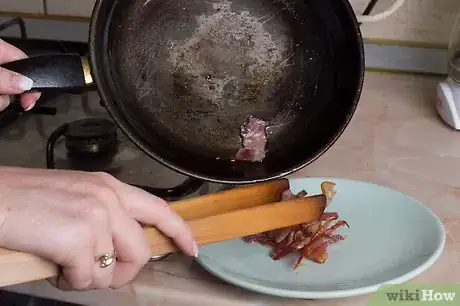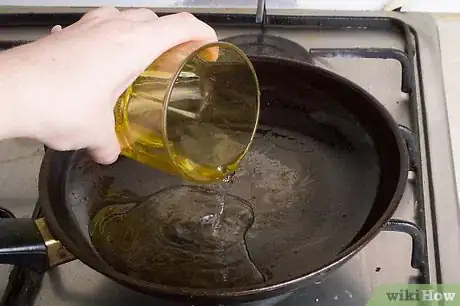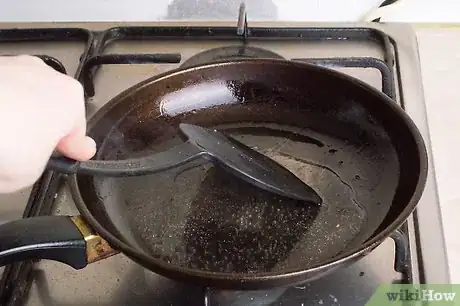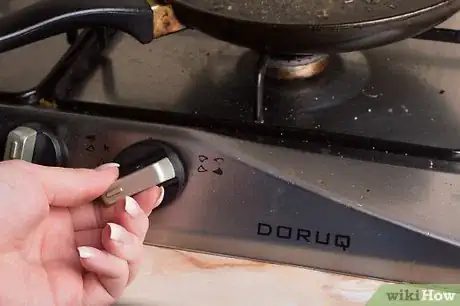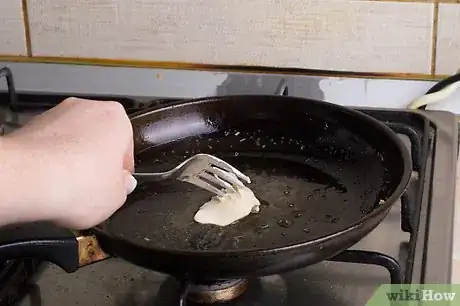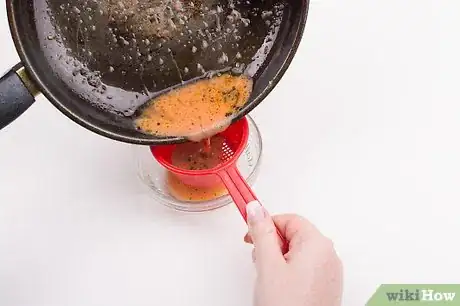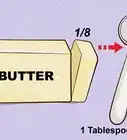This article was co-authored by wikiHow Staff. Our trained team of editors and researchers validate articles for accuracy and comprehensiveness. wikiHow's Content Management Team carefully monitors the work from our editorial staff to ensure that each article is backed by trusted research and meets our high quality standards.
There are 15 references cited in this article, which can be found at the bottom of the page.
wikiHow marks an article as reader-approved once it receives enough positive feedback. In this case, several readers have written to tell us that this article was helpful to them, earning it our reader-approved status.
This article has been viewed 105,060 times.
Learn more...
When you sauté or roast food, especially proteins, much of the flavor comes from complicated browning reactions (caramelization and the Maillard reaction). If you abandon the brown residue at the bottom of the pan, you miss out on the most intense part of the dish. Deglaze the pan instead, dissolving this delicious taste in liquid so you can transform it into a sauce. This process is forgiving and flexible — as long as you start out with a pan that's browned, not burnt.
Steps
Deglazing a Pan
-
1Cook meat or vegetables in a hot pan. Preheat a wide pan, add fat, and continue heating until the oil shimmers, or the butter browns lightly.[1] Add ingredients and cook with minimal stirring. Properly seared meat or sautéed vegetables will leave a brown, sticky residue at the bottom of the pan. This is the "fond," and it contains the flavors that will join your deglazing liquid.[2]
- Stainless steel or enameled cast iron encourage good fonds, and their light color makes it easy to track progress and avoid burning.[3] Nonstick pans are less effective, and reactive metal pans may corrode if deglazed with acid.[4] [5]
- Leave ¼—½ inch (6–13mm) of space between pieces of meat.[6] If overcrowded or cooked at too low a temperature, the meat will steam and fail to form a good fond.
-
2Remove ingredients and skim off excess fat. Transfer the meat or vegetables once they are done cooking, leaving the fond behind. If the pan still contains a lot of fat, spoon it off or pour it through a strainer, returning crusty brown solids to the pan. Too much fat makes the sauce greasy and increases spatter as you deglaze.Advertisement
-
3Choose a deglazing liquid. Wine, homemade stock, or an equal mix of the two are all popular options. If it suits your dish, you can use almost any flavorful liquid. For example, beer works well for robust meat dishes and earthy vegetables, while fruit juice can create a sweet sauce to pair with pork. You can even deglaze with water if you're low on supplies, but this misses the opportunity to add flavor.[7]
- Just avoid dairy, which may curdle over heat.[8]
- Cognac or brandy make a particularly strong sauce, but the vapors may burst into flames. Keep the pan away from flames while pouring, use a long handled pan, and do not put your face over the liquid. Flambéing typically has little effect on flavor, so you can continue to deglaze if this happens — just stay safe.[9] Liquors above 120-proof are too dangerous for this purpose.[10]
-
4Pour in the liquid. As a rule of thumb, use 1 cup (240 mL) liquid for an entree that serves four. Keep in mind that the liquid will reduce down to about half its original volume, and gain an intense flavor.[11] If you don't have time to reduce the sauce, cut the amount of liquid in half.
- Add the liquid slowly or in stages. This will keep the pan hot to help the fond dissolve faster.
-
5Scrape at fond until it dissolves. Heat over a medium-high burner while scraping the base of the pan with a wooden or rubber tool. Continue until the liquid is boiling and most of the fond has dissolved.
-
6Pour over the dish or turn into a pan sauce. Deglazing is a flexible technique. If you're in a hurry, you can use the deglazing liquid as soon as the fond has dissolved. To transform the deglazing liquid into a richer pan sauce, continue to the next section.
Making a Pan Sauce
-
1Add aromatic ingredients. A handful of minced garlic or shallots helps the flavor immensely.[12] You can also add herbs, matching them with the main dish ingredients, or — if you have more time — cook mushrooms, carrots, celery, or onions in the deglazing liquid.
- Add a little salt and pepper now, then taste-test at the end to decide if you need more. A stock-based sauce may already be quite salty after reducing.
-
2Heat until reduced. Boil until about half the liquid is gone, and the remainder is almost syrupy. This concentrates the flavor and evaporates some of the alcohol if present.[13]
- If your deglazing liquid is marinade that has been in contact with raw meat, make sure it reaches a rolling boil before serving.[14]
-
3Finish with fat (optional). For a smooth, rich, sauce, remove the pan from heat and swirl in a bit of cream or melted butter.
-
4Strain the sauce (optional). For an even texture, pour the sauce through a strainer before serving. This step is not necessary unless you are going for a restaurant-style presentation.
Community Q&A
Did you know you can get answers researched by wikiHow Staff?
Unlock staff-researched answers by supporting wikiHow
-
QuestionCan I use vinegar to deglaze?
 wikiHow Staff EditorThis answer was written by one of our trained team of researchers who validated it for accuracy and comprehensiveness.
wikiHow Staff EditorThis answer was written by one of our trained team of researchers who validated it for accuracy and comprehensiveness.
Staff Answer wikiHow Staff EditorStaff Answer
wikiHow Staff EditorStaff Answer -
QuestionShould I cover slow-cooked meat in liquid?
 Community AnswerThere's no need. The portion of the meat above the liquid should still cook fine from the steam, and the sauce will be more intense if you let it reduce. Check occasionally to make sure it hasn't run dry if you're not familiar with the slow cooker, or if you're using a dry cut of meat.
Community AnswerThere's no need. The portion of the meat above the liquid should still cook fine from the steam, and the sauce will be more intense if you let it reduce. Check occasionally to make sure it hasn't run dry if you're not familiar with the slow cooker, or if you're using a dry cut of meat.
Warnings
- Pouring wine over a heated pan may cause a bit of flame to rise from the pan. Be prepared for this to happen, and take the necessary precaution to avoid burns.⧼thumbs_response⧽
- If the fond smells burnt, turns black, or dries out, do not use it.[18] Place the underside of the pan in cold water immediately, then carefully transfer the sauce to a new pan, leaving any burned ingredients behind.⧼thumbs_response⧽
Things You'll Need
- Pan just used to cook meat or vegetables
- Rubber spatula or wooden spoon
- Flavorful liquid of your choice (usually red wine and stock)
- Strainer
- Garlic, herbs, and other flavorful ingredients (optional)
References
- ↑ http://www.reluctantgourmet.com/the-secret-to-great-saute/
- ↑ http://www.cookingforengineers.com/article/244/Fond-of-Fond
- ↑ http://www.cooksillustrated.com/how_tos/5442-do-you-need-a-nonstick-roasting-pan
- ↑ http://www.reluctantgourmet.com/simple-pan-sauces/
- ↑ http://healthycanadians.gc.ca/product-safety-securite-produits/consumer-consommation/education/household-menagers/cook-cuisinier-eng.php
- ↑ http://www.reluctantgourmet.com/simple-pan-sauces/
- ↑ http://www.gourmetsleuth.com/articles/detail/deglaze-a-pan
- ↑ http://www.reluctantgourmet.com/deglazing-what-it-is-and-why-do-it/
- ↑ http://www.culinarylore.com/food-science:alcohol-doesnt-completely-burn-off-in-cooking
- ↑ https://whatscookingamerica.net/flambe.htm
- ↑ http://www.reluctantgourmet.com/simple-pan-sauces/
- ↑ http://www.reluctantgourmet.com/simple-pan-sauces/
- ↑ http://blog.williams-sonoma.com/how-to-braise/
- ↑ http://www.fsis.usda.gov/wps/portal/fsis/topics/food-safety-education/get-answers/food-safety-fact-sheets/safe-food-handling/barbecue-and-food-safety/CT_Index
- ↑ http://www.seriouseats.com/2013/04/ask-the-food-lab-do-i-really-need-to-reduce-w.html
- ↑ https://web.archive.org/web/20160819162746/http://www.ars.usda.gov/SP2UserFiles/Place/80400525/Data/retn/retn06.pdf
- ↑ https://www.cooksillustrated.com/recipes/4026-best-french-onion-soup
- ↑ http://www.thekitchn.com/cooking-basics-knowing-when-to-68599
About This Article
To deglaze a pan, start by browning meat or vegetables in the pan over high heat so a brown, sticky residue forms on the pan. Then, transfer the meat or vegetables to another dish. Pour 1 cup of wine, stock, or other flavorful liquid into the pan. Boil the liquid over medium-high heat while scraping the bottom of the pan with a spatula to loosen the browned bits of food. When the liquid has been reduced by half and all the food particles are dissolved, remove the pan from the heat. Pour the leftover liquid over the prepared food to give it extra flavor.

